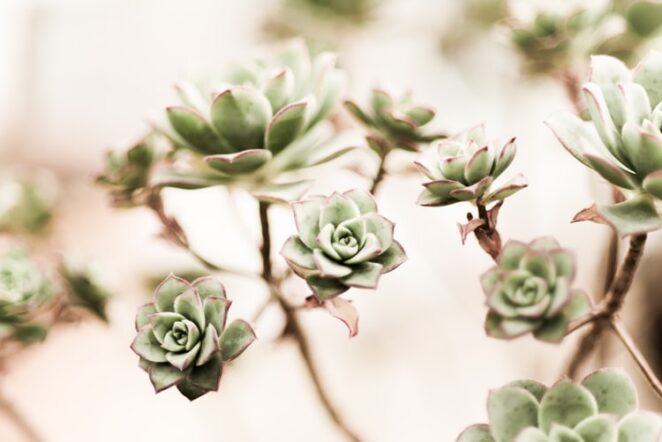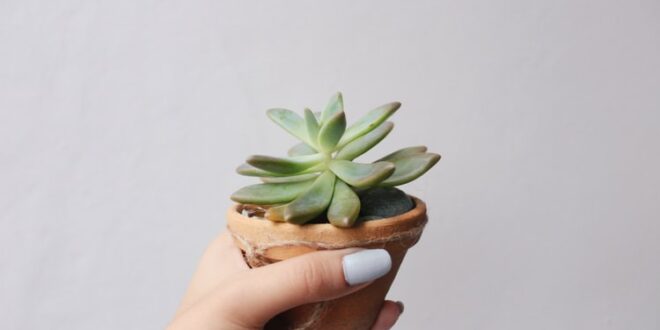Growing plants is not an easy task, even when we are talking about plants that do not require too much attention, such as succulents. There are a number of factors that influence a succulent to die or simply not continue to grow. It can be a consequence of something you do (or don’t do), and sometimes it depends solely on external factors.
Either way, you need to know what could be the cause of why your succulent is not growing so that you can take the necessary measures and help it get back to life as much and as fast as possible. Here are some reasons why your succulent is having a hard time:

-
It gets too much or too little water
One of the main reasons why your succulent does not grow optimally is because it gets too much or too little water. It is very important that you have an adequate watering schedule for these plants that is tailored to their needs. In general, it is necessary to water the succulents once a week or once every two weeks during the summer and high temperatures, while in the winter season it is enough to water it once a month.
The fact is that the succulents that get too much or too little water look quite similar. The leaves lose plumpness and become wilted. They change their color and start to look lifeless. However, if you encounter these symptoms, it is much more likely that the plant needs less water, because succulents adapt very easily to dry conditions and rarely need more water than you provide them.
Tip:
If you want to be completely sure, we suggest that you get a tool called a soil meter that determines the degree of soil moisture. This way you can decide if you need to water your succulent or if you still need to wait a few more days.
-
Succulent lacks necessary nutrients
In case you notice that your succulent is not growing and that the leaves have started to turn yellow, it is possible that the plant is lacking nutrients and that is why these symptoms occur. In such situations, it is good to consider the introduction of a fertilizer that contains all the necessary nutrients and substances that the plant needs for optimal growth.
Soil intended especially for succulents already contains all the necessary ingredients, but over time they are washed with water and the plant absorbs them, so it is necessary to add a new dose of this soil from time to time or go with a fertilizer that is equally good.
How to do it:
Keep in mind that succulents and cacti do not require too many nutrients, and delivering excessive amounts can even have a counter-effect and lead to the development of pests and plant rot. That’s why it’s important to be moderate. Add the fertilizer to the water when watering the plant (approximately once every two weeks), exclusively in the growth phase.
Extra tip:
Ask the succulent sellers what kind of soil and fertilizers they recommend. Succulent market offers a variety of succulents that you will like and beautify your home, and on their blog you can read various tips for optimal plant growth.

-
Succulent is potted in a too small pot
To help the succulents grow in the best possible way, it is necessary to plant them in a pot of the right size. It often happens that people plant a succulent in a pot that is suitable at a given moment, but they do not change it over time and the plant overgrows it. Then problems arise, because the succulent needs space in order to develop adequately. If that space is not provided, the root will not be able to spread as much as needed, the whole plant will be distorted and stop its growth, which you will be able to notice very easily.
Solution:
Try to transplant the succulent into a larger pot once a year to allow it to grow naturally, without any obstacles. Do not transplant it into an oversized container, because that is also not good for it. The pot should be a little bigger than the previous one and allow normal plant progress.
-
It is not getting enough sunlight
Another key factor for optimal succulent growth is a sufficient amount of sunlight. As you know, succulents grow naturally in desert areas where a huge amount of direct sunlight is constantly available to them. If you do not provide it with enough light, it loses the power to perform its natural processes and, consequently, stops growing.
How do you know that plants lack light?
In addition to stopping growth, a succulent can show that it lacks sunlight by twisting its branches and leaves towards a window or other light source, which is a clear sign of what is happening.
What can you do?
Make sure the succulent is always exposed to daylight. If this is not possible, it is a good idea to get grow lamps that ensure that the plant gets enough light, even when it is indoors.

-
It is not the growing season or the plant just needs a little more time
Finally, one more thing to consider is that maybe everything is fine with your plant even if you don’t see it growing. What do we mean by this? There is something called the growing season and it is the period when succulents visibly develop. However, out of this season, you will not see any changes, even if you take adequate care of your plant. And that is completely normal!
Also, some succulents are just slow-growing plants and it will take you months to notice their growth. Be patient, do everything you can, and the results will not be missed!
Conclusion
Succulents are a great addition to any household, because they are very aesthetically attractive, and require minimal dedication and care. However, even this kind of plant can sometimes go through a hard time. If you notice that the plant has not been growing for months or there are changes on it that indicate that something is wrong, try to find out what it is and take all necessary measures to bring it back to life.
 Vermont Republic Second Vermont Republic
Vermont Republic Second Vermont Republic



